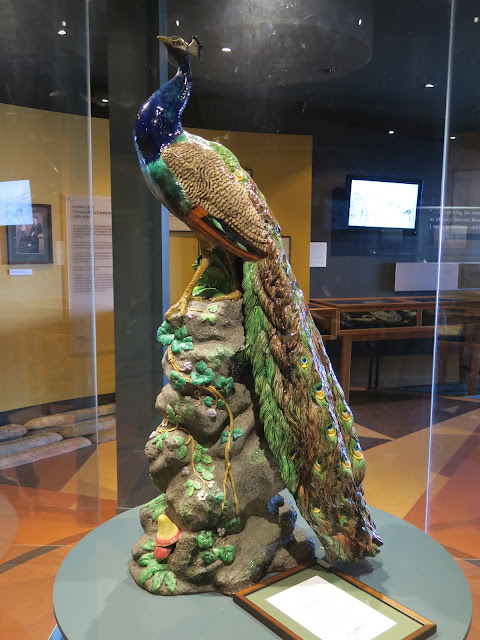The Loch Ard was a three mast iron hulled British clipper ship built in 1863 by the Loch Line of Glasgow to carry cargo and passengers between Liverpool and Melbourne. On March 2, 1878 it left England bound for Melbourne, its third such trip, heavy with cargo and 54 passengers onboard—17 civilians and a crew of 37. Among the cargo onboard were items destined for display at the 1880 International Exhibition in Melbourne. One of these items was a Minton majolica peacock.
The Minton peacock is a life-sized sculpture by French artist Paul Comolera modeled in 1870 and created in majolica in 1873 specifically for Minton. The statue stands slightly under five feet tall with the peacock on a highly detailed rock surrounded by various flora and fauna. Minton only made twelve of these peacocks, although that number is in dispute, and it is believed that nine have survived. It is considered to be among the last surviving examples of Minton’s finest majolica work.
After an uneventful voyage, on May 31, 1878, the Loch Ard encountered bad weather that culminated in a thick fog. The ship veered off course as the ship approached the Australian coast. As the fog lifted in the early hours of June 1, the captain was horrified to discover that the ship had drifted far closer to the coast near Mutton Bird Island than had been expected. Despite attempts to draw the ship back out to sea the vessel crashed against the rocky reef surrounding the island.
The crash devastated the ship. The three masts crumbled blocking attempts to launch the lifeboats and killing some onboard. The vessel sank in fifteen minutes.
All but two of the passengers and crew onboard drowned. The survivors were a teenaged civilian named Eveline (Eva) Carmichael, who lost seven members of her family in the wreck, and a teenaged apprentice midshipman named Tom Pearce. Pearce found his way to shore first when he saw Carmichael struggling to stay afloat in the ocean on a piece of wood. He returned to the water and dragged Eva to safety. The area in which they landed is an area now known as Loch Ard Gorge. The two sheltered in caves on the shore until a local farmer rescued them. The ship itself was considered a total loss.
As word spread of the wreck, a local gentleman by the name of Charles McGillivray found the crate holding the Minton peacock floating in the water and dragged it ashore within a few days of the ship's sinking with hopes of salvaging it. After a disagreement with customs officials over the find, McGillivray abandoned the peacock on the shore. Enter James Miller and Thomas Keys.
Miller was a member of a firm that had bought the salvage rights to the Loch Ard for £2,120 ten days after the disaster. After McGillivray abandoned the peacock on the shore, a storm washed the peacock back into the sea. Miller and Keys had to save it from the ocean for a second time. Before they had a chance to bring the peacock inland, another storm washed the peacock back into the sea. Now, the peacock had been lost and rescued three times from the ocean. When McGillivray first brought the peacock to shore he claimed it was intact except for a chip on the beak. After the third attempt to bring the peacock to land Keys claimed that the bird had the head broken off.
Salvage operations on the remainder of the cargo concluded quickly. £3,000 worth of the cargo that had been salvaged was swept back into the ocean after a storm. It would be another 90 years before the surviving cargo was salvaged. James Miller decided to keep the peacock for himself. It remained with his family until 1940. It was then offered for sale at an antique shop, where it sat for three years until it was sent to auction in 1943. The buyer was Frank Ridley-Lee who kept it in his home in suburban Melbourne. It remained with the Ridley-Lee family until 1975 when it was offered for sale at auction for $4,500—equivalent to approximately $25,000 today. Unable to find a buyer, the Flagstaff Hill Maritime Village in Warrnambool raised money through private donations to purchase the bird for their museum. Today it is on display in the Flagstaff Hill Maritime Village Museum with other objects rescued from the ship where it is known as the Loch Ard Peacock. It's ironic that as a bird the peacock symbolizes survival and resurrection, something this Minton majolica piece certainly speaks to as well.
Pearce and Carmichael remained in Australia for several weeks after the wreck to recover from their trauma. Pearce was lauded as an hero for saving Carmichael and both became local celebrities. Newspapers encouraged a romance between the two teenagers but neither one expressed any interest in the other and the two went their separate ways. Both eventually returned to Great Britain and married others. Tom died in 1909 after a successful career as a captain for the Royal Mail and Eveline died in 1934 after raising a family of three and returning to her birth home of Ireland.
The wreck of the Lock Ard was declared a heritage site on the Victorian Heritage register and remains at the bottom of the ocean off Mutton Bird Island. It has become a tourist attraction for those divers interested in exploring it. It is considered to be among the worst ship wrecks ever to occur off the Australian coast, a coast known for its hundreds of ship wrecks.
















No comments:
Post a Comment